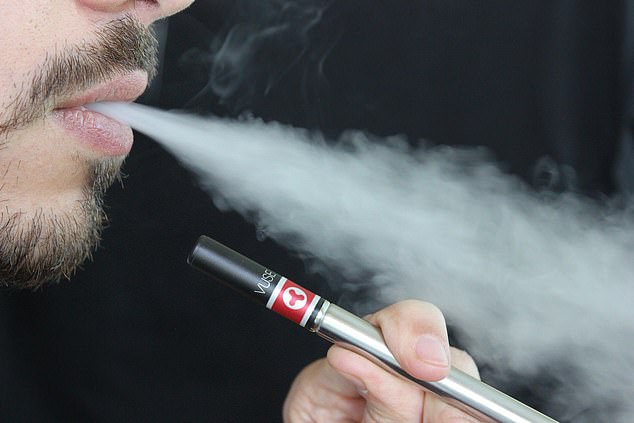Electronic cigarettes have been branded ‘harmful’ by the head of the World Health Organisation (WHO) as he warned their use should be better regulated to protect children and teenagers.
The global health body has recommended that governments bring in measures to stop non-smokers from starting to use e-cigarettes, saying such products are often marketed to young people using an array of different flavours which can ‘hook children on nicotine’.
Better regulation could help prevent ‘renormalising smoking behaviour’ and protect future generations, the WHO said.
Scroll down for video

Electronic cigarettes have been branded ‘harmful’ by the head of the World Health Organisation (WHO) as he warned their use should be better regulated to protect children and teenagers (stock image)
E-cigarette regulations in the UK
In the UK, e-cigarettes are tightly regulated for safety and quality.
You must be 18 or over to buy e-cigarettes or e-liquids in the UK.
It is also illegal for vape adverts to include models who appear to be under the age of 25.
Advertisement
E-cigarettes and vape pens are devices that simulate the feeling of smoking, and are sometimes referred to as electronic nicotine delivery systems.
But the WHO warned that they could act as a ‘gateway’ to tobacco consumption, saying a global systematic review had recently found that children and adolescents using them are more than twice as likely to later use conventional cigarettes.
The sale of e-cigarette products to under-18s is banned in the UK but a recent report on vaping in England recommended that enforcement of age-of-sale regulations for vaping and smoking needs to be improved.
That report, commissioned by Public Health England (PHE) in February, found little change in levels of vaping in recent years, with the prevalence of young people aged 11-18 vaping at least once a month being 4.8 per cent in March 2020.
A fifth of the young people who tried vaping said they had done so before they smoked and 28.9 per cent said they had tried a vaping product and never tried smoking, according to PHE.

E-cigarettes and vape pens are devices that simulate the feeling of smoking, and are sometimes referred to as electronic nicotine delivery systems (stock image)
Vaping ‘doesn’t work as a quitting aid’
Vaping doesn’t work as an aid for quitting tobacco and actually has the opposite effect, suggests new research.
Researchers said there was ‘no evidence that e-cigarettes were helpful in the quit attempt’ in a large-scale study in the US.
Scientists from the University of California in San Diego carried out an analysis of data on 45,971 Americans included in the government-commissioned Population Assessment of Tobacco and Health (PATH) Study.
Participants in the study were interviewed in 2013 and 2014 and are interviewed every year.
A quarter of smokers who tried to quit in the first years of their enrolment used e-cigarettes to help with their attempt. And at their follow-up interview one year later, 9.6 per cent had managed to stay away from tobacco over the previous 12 months.
But even though some had stopped smoking, researchers say the number who quit was hardly different at all from smokers who didn’t use e-cigs.
One of the studies’ authors, Dr John P. Pierce, said: ‘Among this representative sample of US smokers trying to quit, we found no evidence that e-cigarettes were helpful in the quit attempt. This lack of effectiveness was also apparent in the sub-sample who used e-cigarettes on a daily basis for this quit attempt.’
Advertisement
WHO director-general Dr Tedros Adhanom Ghebreyesus said: ‘Nicotine is highly addictive.
‘Electronic nicotine delivery systems are harmful, and must be better regulated.
‘Where they are not banned, governments should adopt appropriate policies to protect their populations from the harms of electronic nicotine delivery systems, and to prevent their uptake by children, adolescents and other vulnerable groups.’
In the WHO report published on Tuesday, Dr Tedros said electronic devices were being ‘promoted aggressively as ‘safer’ or ‘smoke-free’ alternatives to cigarettes’ and that the tobacco and related industries are using ‘the same old marketing tactics to promote new tools to hook children on nicotine and circumvent tobacco legislation’.
Dr Adriana Blanco Marquizo, head of secretariat of the WHO Framework Convention on Tobacco Control (FCTC) said more research is needed on any possible effects of e-cigarettes.
She said: ‘Until independent research shows the real risk profile of these products, governments should be cautious. Science-based evidence, not marketing, should guide their actions.’
But Professor John Britton accused the WHO of not understanding the ‘fundamental difference’ between a deadly tobacco addiction and being addicted to nicotine.
The emeritus Professor of Epidemiology at University of Nottingham, said: ‘This report demonstrates that, sadly, the WHO still doesn’t understand the fundamental difference between addiction to tobacco smoking, which kills millions of people every year, and addiction to nicotine, which doesn’t.
‘The WHO is also evidently still content with the hypocrisy of adopting a position which recommends the use of medicinal nicotine products to treat addiction to smoking, but advocates prohibition of consumer nicotine products which do the same thing, but better.

The sale of e-cigarette products to under-18s is banned in the UK but a recent report on vaping in England recommended that enforcement of age-of-sale regulations for vaping and smoking needs to be improved (stock image)
‘The WHO is right that non-smokers, especially children, should be discouraged from using any nicotine product. But for the more than one billion tobacco smokers in the world, electronic nicotine delivery systems are part of the solution, not the problem.’
Dr Derek Yach, president of the Foundation for a Smoke-Free World, described the WHO’s approach to tobacco control as ‘fundamentally flawed’.
He said: ‘The exceptional growth of next generation devices offers the WHO a real opportunity to tackle combustible consumption once and for all.
‘Over 100 million ex-smokers use reduced-risk products and the WHO should be taking advantage of massive investment in the sector by encouraging governments to provide an incentivised regulatory framework to enable greater expansion.’
The WHO said three-quarters of countries and 5.3 billion people are currently protected by at least one tobacco control measure, and 50 per cent of countries are protected by at least two measures.
It described the ‘encouraging progress’ seen around the world, with smoking prevalence among people aged over 15 years having fallen from 22.7 per cent to 17.5 per cent.
What is an e-cigarette and how is it different to smoking tobacco?
An electronic cigarette (e-cigarette) is a device that allows users to inhale nicotine by heating a vapour from a solution that contain nicotine, propylene and flavourings.
As there is no burning involved, there is no smoke like a traditional cigarette.
But while they have been branded as carrying a lower risk than cigarettes, an increasing swell of studies is showing health dangers.
E-cigarettes do not produce tar or carbon monoxide, but the vapor does contain some harmful chemicals.
Nicotine is the highly addictive chemical which makes it difficult for smokers to quit.
Nearly three million people in Britain use e-cigarettes, and more than nine million Americans.
TYPES:
1. Standard e-cigarette
Battery-powered device containing nicotine e-liquid.
It vaporizes flavored nicotine liquid.
2. Juul
Very similar to normal e-cigarettes but with sleeker design and, in the US, a higher concentration of nicotine. In the UK and EU limited to 20 mg/ml.
Thanks to its ‘nicotine salts’, manufacturers claim one pod delivers the amount of nicotine as a pack of cigarettes.
It is composed of an e-cigarette (battery and temperature control), and a pod of e-liquid which is inserted at the end.
The liquid contains nicotine, chemicals and flavorings.
Like other vaping devices, it vaporizes the e-liquid.
3. IQOS by Philip Morris
Pen-shaped, charged like an iPod.
Vaporizes tobacco.
It is known as a ‘heat not burn’ smokeless device, heating tobacco but not burning it (at 350C compared to 600C as normal cigarettes do).
The company claims this method lowers users’ exposure to carcinogen from burning tobacco.
Advertisement
Source link : https://www.dailymail.co.uk/sciencetech/article-9830321/WHO-calls-restrictions-harmful-e-cigarettes.html











